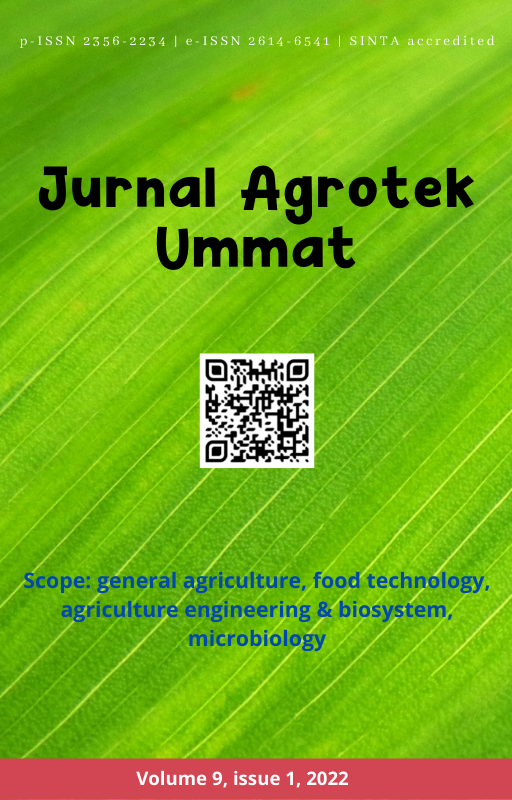Application of rice husk biochar and a combination of urea, SP 36 and KCl on yield components and yields of glutinous corn (Zea mays Ceratina) on ultisols
DOI:
https://doi.org/10.31764/jau.v9i1.5773Keywords:
anorganic fertilizer, biochar, sweet cornAbstract
Glutinous corn or pulut (Zea mays Ceratina) is a type of corn that is currently in demand by the public. The productivity of glutinous corn is low because corn planting is generally carried out on Ultisol type soils with acidic characteristics and poor in nutrients. This study aims to determine the effect of the application of biochar and inorganic fertilizers (urea, SP 36 and KCl on the yield and yield components of glutinous corn plants. The test method was carried out by factorial RAK with two factors. The first factor was the dose of rice husk biochar (0, 5, 10). and 15 ton ha-1) and the second factor is a combination of inorganic fertilizers (Urea, SP 36 and KCl). The treatment dose of biochar is 10 tons ha-1 and acombination of fertilizers 200 kg ha-1 Urea + 75 kg ha-1 SP-36 + 75 kg ha-1 KCl gave the best yield on plant height, number of leaves, length of cob, weight of cob per plant, weight of cob per plot.
References
Abdilah, A., Lubis, K. S., & Mukhlis, M. (2018). Perubahan Beberapa Sifat Kimia Tanah dan Pertumbuhan Tanaman Jagung (Zea mays L.) Akibat Pemberian Limbah Kertas Rokok dan Pupuk Kandang Ayam di Tanah Ultisol. Jurnal Agroekoteknologi FP USU, 6(3), 442–447. https://talenta.usu.ac.id/joa/article/view/2371/1760
Anwar, M. Z., & Isami, T. (2019). Respon Pertumbuhan dan Hasil Tanaman Jagung Ketan (Zea mays ceratina) dengan 3 Jenis Pemberian Pupuk Kandang dan Pupuk Organik. Produksi Tanaman, 7(9), 1694–1700. https://doi.org/10.32503/hijau.v4i2.637
Bahri, S., Merismon, M., & Sutejo, S. (2020). Pemanfaatan bichar dan pupuk kandang ayam pada pertanaman jagung hibrida di tanah ultisol. Jurnal Galung Tropika, 9(2), 115–123. https://doi.org/http://dx.doi.org/10.31850/jgt.v9i2.599
Chairunas, Aziz, A., Bakar, B. A., & Darmadi, D. (2014). Prosiding Seminar Nasional Agroinovasi Spesifik Lokasi Untuk Ketahanan Pangan Pada Era Masyarakat Ekonomi Asean Pemanfaatan Biochar dan Efisiensi Pemupukan Jagung Mendukung Program Pengelolaan Tanaman Terpadu Di Provinsi Aceh. 224–234. https://lampung.litbang.pertanian.go.id/ind/images/stories/publikasi/prosiding_1_2017/27.cairunass.pdf
Dai, Z., Xiong, X., Zhu, H., Xu, H., Leng, P., Li, J., Tang, C., & Xu, J. (2021). Association of biochar properties with changes in soil bacterial, fungal and fauna communities and nutrient cycling processes. Biochar, 3(3), 239–254. https://doi.org/10.1007/s42773-021-00099-x
Fitriyah, N. (2019). Respon Pertumbuhan dan Produksi Jagung Pulut Lokal (Zea mays ceratina. L) pada Kondisi Cekaman Kering dan Nitrogen Rendah. Jurnal Ilmiah Hiau Cendekia, 2(4), 74–77.
Herman, W., & Resigia, E. (2018). Jerami Padi Terhadap Pertumbuhan dan Produksi Padi ( Oryza Sativa ) Pada Tanah Ordo Ultisol. Jurnal Ilmiah Pertanian, 15(1), 42–50.
Holilullah, H., Afandi, A., & Novpriansyah, H. (2015). Karakterisitk Sifat Fisik Tanah Pada Lahan Produksi Rendah Dan Tinggi Di Pt Great Giant Pineapple. Jurnal Agrotek Tropika, 3(2), 278–282. https://doi.org/10.23960/jat.v3i2.2014
Jamili, M. J., Sjofjan, J., & Amri, A. I. (2017). Pengaruh Jerami Padi dan Rasio Pupuk Urea, TSP, KCl terhadap Pertumbuhan dan Produksi Kedelai (Glycine max (L) Merril.). JOM Faperta, 4(1), 1–14. https://jom.unri.ac.id/index.php/JOMFAPERTA/article/view/16778/16202
Kim, H. J., & Li, X. (2016). Effects of phosphorus on shoot and root growth, partitioning, and phosphorus utilization efficiency in Lantana. HortScience, 51(8), 1001–1009. https://doi.org/10.21273/hortsci.51.8.1001
Muhidin, A. . A., Darusman, & Manfarizah. (2017). Perubahan Sifat Fisika Ultisol Akibat Pembenah Tanah Dan Pola Tanam. Prosiding Seminar Nasional Pascasarjana (SNP) Unsiyah, 9(3), 120–130. http://www.jurnal.unsyiah.ac.id/SNP-Unsyiah/article/view/6930/5673
Putri, V. I., Mukhlis, & Benny Hidaya. (2017). Pemberian Beberapa Jenis Biochar Untuk Memperbaiki Sifat Kimia Tanah Ultisol Dan Pertumbuhan Tanaman Jagung. Agroekoteknologi,5(4), 824–828. https://doi.org/10.32734/jaet.v5i4.16435
Shalsabila, F., Prijono, S., & Kusuma, Z. (2017). Pengaruh aplikasi biochar kulit kakao terhadap kemantapan agregat dan produksi tanaman jagung pada ultisol lampung timur. Jurnal Tanah Dan Sumberdaya Lahan, 4(1), 473–480.
Situmeang, Y. P., & Sudewa, K. A. (2013). Respon pertumbuhan vegetatif tanaman jagung pulut pada aplikasi biochar limbah bambu. Prosiding Seminar Nasional Dalam Rangka Dies Natalis Ke- 29 Universitas Warmadewa, 144–147. Respon pertumbuhan vegetatif tanaman jagung pulut pada aplikasi biochar limbah bambu
Sudaryono, S. (2016). Tingkat Kesuburan Tanah Ultisol Pada Lahan Pertambangan Batubara Sangatta, Kalimantan Timur.Jurnal Teknologi Lingkungan, 10(3), 337–346. https://doi.org/10.29122/jtl.v10i3.1480
Verdiana, A., Miranti, Thamrin, S., & Titin, S. (2016). The Effect Of Various Doses Biochar RiceHuskand Npk Fertilizer On The Growth And Yield Of Maize (Zea mays L.). Jurnal Produksi Tanaman, 4(8), 611–616.
Xiang, Y., Deng, Q., Duan, H., & Guo, Y. (2017). Effects of biochar application on root traits: a meta-analysis. GCB Bioenergy, 9(10), 1563–1572. https://doi.org/10.1111/gcbb.12449
Yulnafatmawita, & Adrinal. (2014). Physical characteristics of ultisols and the impact on soil loss during soybean (Glycine max Merr) cultivation in a wet tropical area. Agrivita, 36(1), 57–64. https://doi.org/10.17503/agrivita-2014-36-1-p057-064
Downloads
Published
Issue
Section
License
Authors who publish articles in Jurnal Agrotek Ummatagree to the following terms:- Authors retain copyright of the article and grant the journal right of first publication with the work simultaneously licensed under a CC-BY-SA or The Creative Commons Attribution–ShareAlike License.
- Authors are able to enter into separate, additional contractual arrangements for the non-exclusive distribution of the journal's published version of the work (e.g., post it to an institutional repository or publish it in a book), with an acknowledgment of its initial publication in this journal.
- Authors are permitted and encouraged to post their work online (e.g., in institutional repositories or on their website) prior to and during the submission process, as it can lead to productive exchanges, as well as earlier and greater citation of published work (See The Effect of Open Access).

